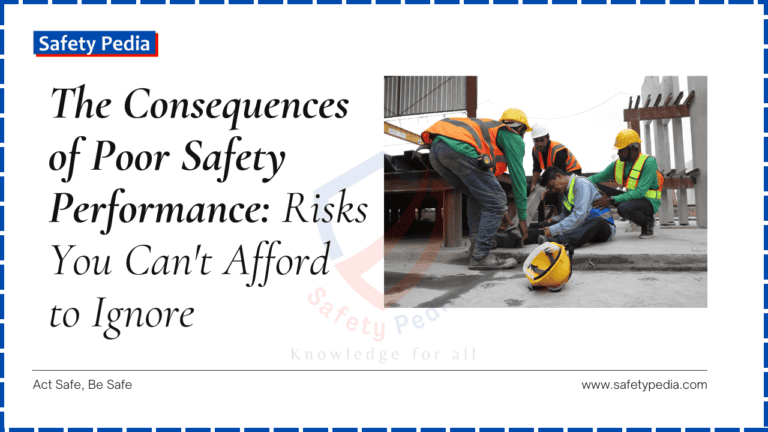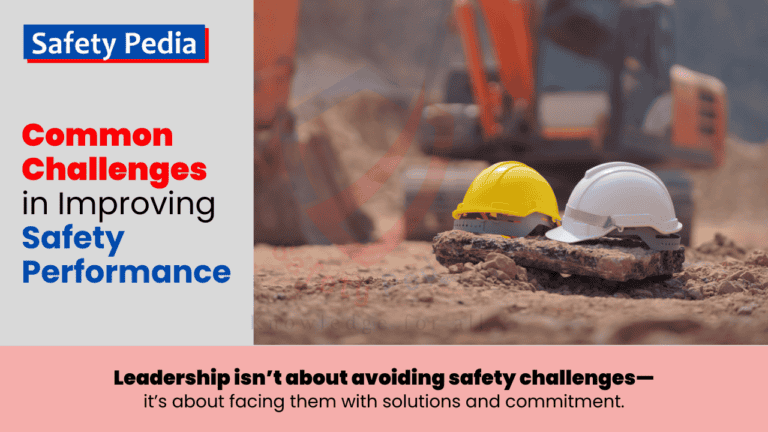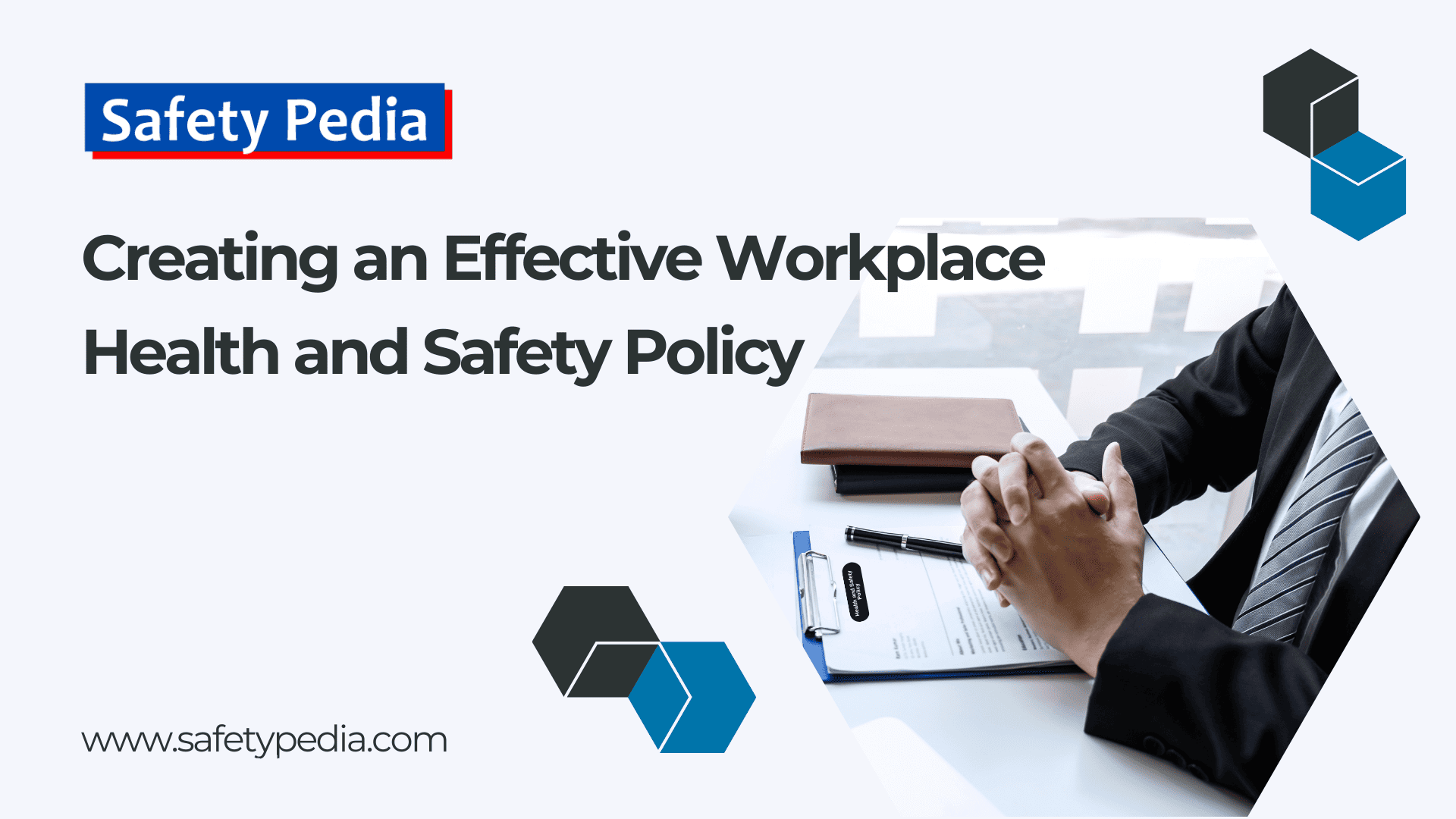What is a workplace health and safety policy?
A workplace health and safety policy is a written statement of an organization’s commitment to the health and safety of its employees and stakeholders through its operations. Management endorsed the commitment of its employees regarding their health and safety.
Why do we need a written safety policy?
A workplace health and safety policy aims to prevent accidents and illnesses and ensure employees have a safe and healthy working environment. It outlines the company’s approach to health and safety management, including its goals, responsibilities for implementing and enforcing safety measures, and procedures for preventing accidents and injuries, promoting safe work practices, and protecting the health and well-being of workers.
The policy may also include information on hazard identification and risk assessment, reporting and investigating incidents, emergency procedures, health and safety training, and the provision of personal protective equipment and other safety measures. The company’s management should develop it in consultation and participation with workers. It may be reviewed and updated regularly to reflect workplace changes and remain relevant and practical.
A workplace health and safety policy is essential for creating a safe and healthy working environment. It can help to reduce the risk of accidents, injuries, and illnesses at work.
Importance of Health And Safety Policy
A health and safety policy is an essential tool for any organization because it:
- Promotes a Safe Work Environment: A well-designed health and safety policy sets clear expectations and procedures for maintaining a safe and healthy workplace, reducing the risk of accidents and incidents.
- Demonstrates Commitment to Employee Safety: A strong health and safety policy conveys to employees, customers, and other stakeholders that the organization is very committed to providing a safe work environment.
- Supports Legal Compliance: Health and safety policies help organizations comply with occupational health and safety regulations and laws, reducing the risk of fines and legal action.
- Increases Productivity: By reducing the risk of accidents and incidents, a health and safety policy can help increase productivity and reduce the costs associated with workplace injuries and illnesses.
- Reduce cost: Every accident costs an organization directly or indirectly. Managing health and safety can help reduce accidents and, ultimately, the costs associated with these accidents or incidents.
- Enhances Reputation: An effective health and safety policy can improve an organization’s reputation by demonstrating its commitment to responsible and ethical business practices.
- Facilitates Continuous Improvement: A health and safety policy provides a framework for continuous improvement, helping organizations to identify and eliminate hazards and to make ongoing improvements to the health and safety of their workplace.
Overall, a health and safety policy is an essential component of a comprehensive occupational health and safety management system and is critical to ensuring the health and well-being of employees and the organization’s success.
Key Elements of Health and Safety Policy According to ISO 45001
ISO 45001 is an international standard for occupational health and safety management systems. The standard outlines the key elements of a health and safety policy as follows:
- Commitment: A statement indicating the company’s commitment to providing its employees with a safe and healthy work environment.
- Context of the organization: The policy should consider the organization’s context, including its external and internal factors and the needs and expectations of interested parties.
- Leadership and worker participation: The policy should demonstrate the organization’s commitment to health and safety and involve workers in decision-making and implementation.
- Hazard identification, assessment, and control: The policy should include processes for identifying and assessing hazards and implementing appropriate control measures.
- Objectives and programs: The policy should establish health and safety objectives and implement programs to achieve them.
- Performance measurement and evaluation: The policy should include a process for monitoring and measuring health and safety performance and making improvements as necessary.
- Communication, participation, and consultation: The policy should outline processes for communicating with workers and other interested parties and involving them in health and safety matters.
- Documentation: The policy should be documented and available to all relevant parties. Remember, the top senior management must sign the HSE policy to show their commitment and first priority towards health, safety, and the environment.
- Responsibilities: A clear definition of the roles and responsibilities of top management, middle management, and employees in maintaining a safe and healthy work environment.
- Accident and Incident Investigation: A procedure for conducting investigations of accidents and incidents in the workplace.
- Safe Work Procedures: Detailed procedures for performing tasks safely, including emergency response procedures.
- Training: A program for providing health and safety training to employees, including new employee orientation and ongoing training for all employees.
- Personal Protective Equipment: Provision arrangements of appropriate personal protective equipment for employees when required.
- Health and Safety Inspections: Regular workplace inspections program to identify and correct potential hazards.
- Emergency Preparedness: Procedures for responding to emergencies, including evacuation plans and emergency response teams.
- Record Keeping: A system for maintaining records of health and safety incidents, hazards, and corrective actions.
- Review and Evaluation: A process for regularly reviewing and evaluating the health and safety program’s effectiveness and making necessary improvements.
- Continuous improvement: The policy should include a process for continuous improvement of the occupational health and safety management system. Set a tangible approach to improve workplace health, safety, and environmental conditions continually.
How to write an effective health and safety policy?
Writing an effective health and safety policy involves communicating an organization’s commitment to maintaining a safe and healthy workplace. Here are key steps to follow:
1. Start with a Clear Statement of Intent
When writing a health and safety policy, write a clear statement of intent, as it sets the tone for the entire document and establishes the organization’s commitment to employee well-being. The statement should clearly express the company’s dedication to providing a safe and healthy work environment, free from hazards that could cause injury or illness. It should highlight the organization’s goals, such as preventing accidents, promoting health, and ensuring regulatory compliance.
By outlining these objectives upfront, the policy demonstrates management’s proactive approach to safety and provides employees with a clear understanding of the company’s priorities regarding their health and safety.
2. Define Roles and Responsibilities
Define clear roles and responsibilities as they are vital to health and safety policy. It ensures everyone understands their duties in maintaining a safe work environment. Management should be responsible for providing the necessary resources, training, and leadership to support health and safety initiatives. This includes implementing safety protocols, ensuring regulation compliance, and conducting regular audits and reviews. On the other hand, employees are responsible for adhering to safety procedures, reporting hazards, participating in training, and using protective equipment when required.
By specifying these roles, the policy ensures accountability at all levels, promotes a shared commitment to safety, and promotes a culture where everyone is actively involved in creating a safer workplace.
3. Identify Key Health and Safety Objectives
Write key health and safety objectives that provide clear, actionable goals and lead the organization’s health and safety efforts. Objectives should be specific, such as reducing workplace accidents by a certain percentage, ensuring all employees receive regular safety training, or improving emergency response times. Setting SMART objectives allows the company to track progress, assess the effectiveness of safety programs, and identify areas for improvement.
By clearly defining these objectives, the organization can prioritize actions, allocate resources more effectively, and promote a culture of continuous improvement in health and safety practices.
4. Risk Assessment Procedures
State risk assessment procedures while creating health and safety policies. It provides a systematic approach to identifying, evaluating, and managing potential hazards in the workplace. The policy should outline how risks will be assessed regularly, including physical and environmental hazards and any risks related to human factors or equipment. This involves conducting thorough inspections, engaging employees in hazard identification, and using tools like risk matrices or safety audits. The policy should also detail how identified risks will be prioritized based on their severity and likelihood and what control measures will be implemented to mitigate them.
By incorporating comprehensive risk assessment procedures, the policy helps ensure proactive risk management, reducing the likelihood of accidents and enhancing overall workplace safety.
5. Health and Safety Procedures
The policy should outline Health and safety procedures, as they provide clear guidelines for managing specific risks and ensuring a safe working environment. These procedures should cover all critical workplace areas, such as the safe handling of hazardous materials, machine operation protocols, emergency response plans, and personal protective equipment (PPE). Each procedure must be detailed and tailored to address the unique risks associated with various tasks and work environments. The policy should outline how employees will be trained on these procedures, when and how safety inspections will occur, and the steps to take in the event of an accident or emergency. Furthermore, it should include a process for employees to report hazards and near-misses, ensuring ongoing vigilance.
By establishing well-defined health and safety procedures, organizations create a structured approach to mitigating risks, ensuring compliance with safety regulations, and empowering employees to act safely and responsibly in their daily tasks.
6. Training and Education
The policy should outline the importance of regular, comprehensive training programs for all employees, sub-contractors or interested parties, tailored to their specific roles and the hazards they may encounter. This includes initial onboarding orientation training, refresher courses, and specialized sessions for high-risk tasks or equipment. Employees should be educated on safety procedures, emergency protocols, proper personal protective equipment (PPE) use, and how to report hazards or unsafe conditions.
Additionally, the policy should emphasize the need for ongoing education to keep the workforce updated on changing regulations, new technologies, and evolving safety practices. By prioritizing training and education, organizations can cultivate a safety culture, reduce the likelihood of accidents, and ensure that employees are prepared to act responsibly.
7. Monitoring and Review
The policy should specify how health and safety performance will be continuously monitored through regular inspections, audits, incident reporting, and employee feedback. This ongoing assessment allows organizations to identify gaps or areas for improvement in their safety practices. Furthermore, the policy should include a process for regularly reviewing safety procedures and updating them based on new risks, regulatory changes, or lessons learned from incidents.
A robust monitoring and review system enables the organization to make data-driven decisions, track progress toward safety goals, and make necessary adjustments to prevent accidents or injuries. By incorporating these practices, organizations can ensure that their health and safety efforts are proactive, adaptable, and continuously improving.
8. Employee Consultation and Involvement
The policy should emphasize the importance of actively engaging employees in safety discussions, decision-making, and the identification of hazards. This can be achieved through regular safety meetings, committees, or feedback systems that encourage employees to share their insights and concerns.
By involving workers in developing and reviewing safety procedures, the organization can tap into their firsthand knowledge of potential risks and practical solutions. Furthermore, when employees feel heard and valued, they are more likely to take ownership of their safety responsibilities and adhere to safety protocols. Ensuring ongoing consultation and involvement enhances safety and helps build a positive safety culture where everyone is committed to maintaining a safe and healthy work environment.
9. Legal and Regulatory Compliance
The policy should clearly outline the organization’s commitment to adhering to these legal requirements, including workplace safety standards, environmental protections, and employee rights. The policy must incorporate up-to-date legal obligations, such as correctly handling hazardous materials, reporting procedures for incidents, and compliance with occupational health regulations.
Additionally, the policy should define the process for monitoring and staying informed about regulation changes and how the company will adjust its practices to remain compliant. By prioritizing legal and regulatory compliance, the organization avoids legal penalties and demonstrates its dedication to providing a safe and lawful working environment for all employees.
10. Signatures of Senior Management
Get signatures from senior management on health and safety policy, demonstrating top-down commitment and accountability. When senior leaders sign the policy, it sends a clear message to all employees that health and safety are both a priority and integral to the organization’s values and operations.
This formal endorsement ensures that the policy is taken seriously and reinforces management’s responsibility to provide the necessary resources, support, and leadership to implement the policy effectively. Additionally, senior management’s involvement in signing the policy helps promote a safety culture throughout the organization, as employees see their leaders actively promoting a safe and healthy work environment. The signatures also serve as a reference point, holding management accountable for the ongoing success of the health and safety initiatives outlined in the policy.
Why is it important to review safety policy?
It is essential to regularly review a company’s health and safety policy to ensure that it remains effective and relevant to current circumstances. There are several reasons why this is necessary:
- Compliance with laws and regulations: Health and safety laws and regulations can change over time, so it’s essential to ensure that the policy stays up-to-date and complies with current requirements.
- Adaptation with technology: New technologies are rapidly evolving, and many advances, such as artificial intelligence (AI), can help to reduce accidents or incidents. Therefore, ensuring that the safety policy keeps evolving and integrating new technologies is essential.
- Protection of employees: A comprehensive and effective health and safety policy review can help protect employees from accidents, illnesses, and other work-related hazards.
- Improvement of working conditions: Regular reviews can identify improvement areas and help create a safer and healthier workplace for employees.
- Reduction of liability: A well-designed health and safety policy can help reduce a company’s liability in an accident or illness.
- Demonstration of commitment: Regular reviews demonstrate a company’s commitment to health and safety and can help to improve employee morale and engagement.
Overall, regularly reviewing a company’s health and safety policy is critical to a comprehensive health and safety program and helps ensure employees’ well-being and safety.
Conclusion:
In conclusion, creating an effective health and safety policy is essential for promoting a safe and healthy workplace where employees can perform their duties without unnecessary risk. A well-structured policy, which includes clear statements of intent, defined roles and responsibilities, comprehensive risk assessment procedures, safety protocols, training and education, and ongoing monitoring, ensures that safety is prioritized at all levels of the organization. Employee consultation and involvement, legal compliance, and senior management endorsement further strengthen the policy’s effectiveness and commitment.
Organizations can continuously improve their safety practices by regularly reviewing and updating the policy to address emerging risks and regulatory changes. Ultimately, a strong health and safety policy not only protects employees but also promotes a culture of safety, enhancing productivity, reducing incidents, and contributing to the organisation’s long-term success.
References
1. https://www.gov.nl.ca/dgsnl/ohs/safety-info/si-safety-programs/#15
Your one click can make a difference
Keep sharing and promoting health and safety awareness!
Related posts:

The Consequences of Poor Safety Performance: Risks You Can’t Afford to Ignore
Discover the potential consequences of poor safety performance in the workplace and how they can negatively impact both employees and the company as a whole.

18 Common Challenges in Improving Safety Performance at Work
Discover 18 common challenges in improving safety performance at work. Learn how to overcome these obstacles for a safer workplace.

20 Best Ways to Improve Safety Performance in the Workplace
Discover the 20 best ways to improve safety performance at workplace, including actionable strategies for hazard prevention, employee engagement, safety training, and cultivating a culture of well-being.

